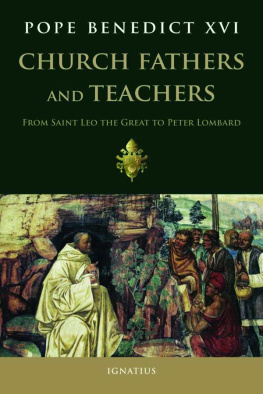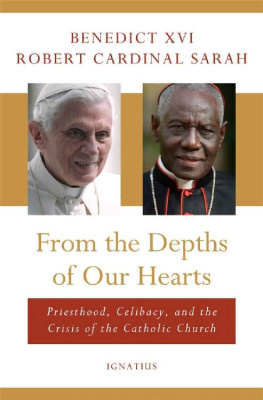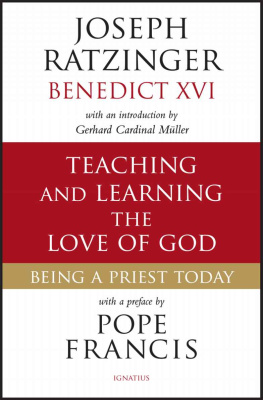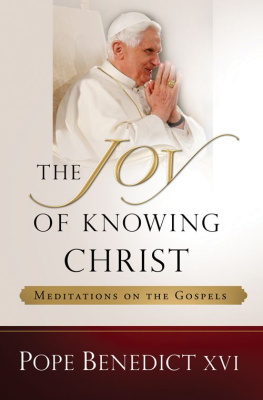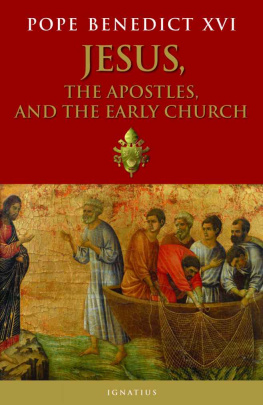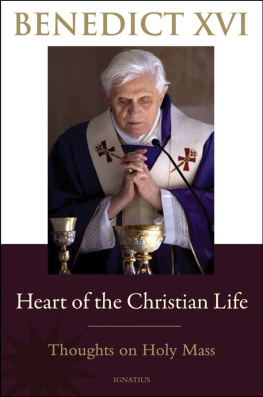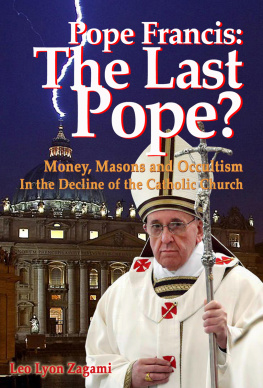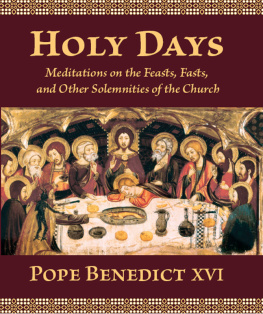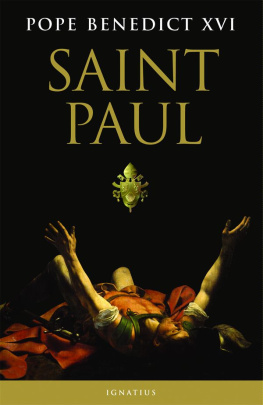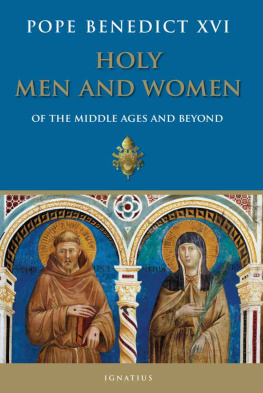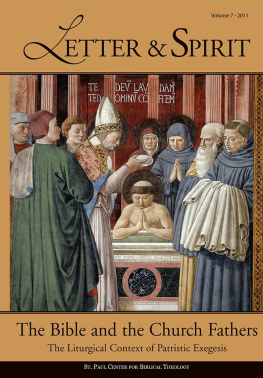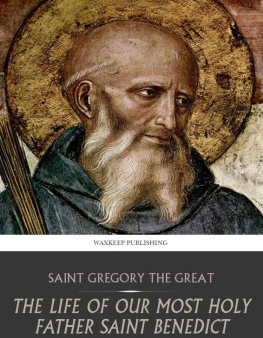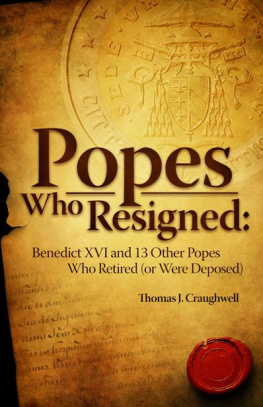CHURCH FATHERS AND TEACHERS
From Saint Leo the Great to Peter Lombard
POPE BENEDICT XVI
CHURCH FATHERS
AND TEACHERS
From Saint Leo the Great to
Peter Lombard
General Audiences
5 March 2008-25 June 2008
11 February 200917 June 2009
2 September 200930 December 2009
IGNATIUS PRESS SAN FRANCISCO
English translation by LOsservatore Romano
Cover art: From The Life of Saint Benedict
(From a series of paintings completed between 1497-1508)
Saint Benedict Instructing the People in Sacred Doctrine
By Sodoma (Bazzi), Giovanni Antonio
Abbey, Monte Oliveto Maggiore, Italy
Erich Lessing/Art Resource, New York
Papal coat of arms image by www.AgnusImages.com
Cover design by Roxanne Mei Lum
2010 by Libreria Editrice Vaticana, Vatican City
All rights reserved
ISBN 978-1-58617-317-3
Library of Congress Control Number 2010922762
Printed in the United States of America
CONTENTS
Saint Leo the Great
WEDNESDAY, 5 MARCH 2008
Paul VI Audience Hall
Dear Brothers and Sisters ,
Continuing our journey through the Fathers of the Church, true stars that shine in the distance, at our meeting today we encounter a Pope who in 1754 Benedict XIV proclaimed a Doctor of the Church: Saint Leo the Great. As the title soon attributed to him by tradition suggests, he was truly one of the greatest Pontiffs to have honored the Roman See and made a very important contribution to strengthening its authority and prestige. He was the first Bishop of Rome to have been called Leo, a name used subsequently by another twelve Supreme Pontiffs, and was also the first Pope whose preaching to the people who gathered around him during celebrations has come down to us. We spontaneously think of him also in the context of todays Wednesday General Audiences, events that in past decades have become a customary meeting of the Bishop of Rome with the faithful and the many visitors from every part of the world.
Leo was a Tuscan native. In about the year 430 A.D., he became a deacon of the Church of Rome, in which he acquired over time a very important position. In the year 440 his prominent role induced Galla Placidia, who then ruled the Empire of the West, to send him to Gaul to heal a difficult situation. But in the summer of that year, Pope Sixtus III, whose name is associated with the magnificent mosaics in Saint Mary Majors, died, and it was Leo who was elected to succeed him. Leo heard the news precisely while he was carrying out his peace mission in Gaul. Having returned to Rome, the new Pope was consecrated on 29 September 440. This is how his Pontificate began. It lasted more than twenty-one years and was undoubtedly one of the most important in the Churchs history. Pope Leo died on 10 November 461 and was buried near the tomb of Saint Peter. Today, his relics are preserved in one of the altars in the Vatican Basilica.
The times in which Pope Leo lived were very difficult: constant barbarian invasions, the gradual weakening of imperial authority in the West, and the long, drawn-out social crisis forced the Bishop of Romeas was to happen even more obviously a century and a half later during the Pontificate of Gregory the Greatto play an important role in civil and political events. This, naturally, could only add to the importance and prestige of the Roman See. The fame of one particular episode in Leos life has endured. It dates back to 452, when the Pope, together with a Roman delegation, met Attila, chief of the Huns, in Mantua and dissuaded him from continuing the war of invasion by which he had already devastated the northeastern regions of Italy. Thus, he saved the rest of the Peninsula. This important event soon became memorable and lives on as an emblematic sign of the Pontiffs action for peace. Unfortunately, the outcome of another Papal initiative three years later was not as successful, yet it was a sign of courage that still amazes us: in the spring of 455 Leo did not manage to prevent Genserics Vandals, who had reached the gates of Rome, from invading the undefended city that they plundered for two weeks. This gesture of the Popewho, defenseless and surrounded by his clergy, went forth to meet the invader to implore him to desistnevertheless prevented Rome from being burned and assured that the Basilicas of Saint Peter, Saint Paul, and Saint John, in which part of the terrified population sought refuge, were spared.
We are familiar with Pope Leos action thanks to his most beautiful sermonsalmost one hundred in a splendid and clear Latin have been preservedand thanks to his approximately 150 letters. In these texts the Pontiff appears in all his greatness, devoted to the service of truth in charity through an assiduous exercise of the Word which shows him to us as both theologian and pastor. Leo the Great, constantly thoughtful of his faithful and of the people of Rome but also of communion between the different Churches and of their needs, was a tireless champion and upholder of the Roman Primacy, presenting himself as the Apostle Peters authentic heir: the many Bishops who gathered at the Council of Chalcedon, the majority of whom came from the East, were well aware of this.
This Council, held in 451 and in which 350 Bishops took part, was the most important assembly ever to have been celebrated in the history of the Church. Chalcedon represents the actual Christological goal of the three previous Ecumenical Councils: Nicaea in 325, Constantinople in 381, and Ephesus in 431. By the sixth century these four Councils that sum up the faith of the ancient Church were already being compared to the four Gospels. This is what Gregory the Great affirms in a famous letter (I, 24): I confess that I receive and revere, as the four books of the Gospel, so also the four Councils, because on them, Gregory explains further, as on a four-square stone, rises the structure of the holy faith. The Council of Chalcedon, which rejected the heresy of Eutyches, who denied the true human nature of the Son of God, affirmed the union in his one Person, without confusion and without separation, of his two natures, human and divine.
The Pope asserted this faith in Jesus Christ, true God and true man, in an important doctrinal text addressed to the Bishop of Constantinople, the so-called Tome to Flavian , which, read at Chalcedon, was received by the Bishops present with an eloquent acclamation. Information on it has been preserved in the proceedings of the Council: Peter has spoken through the mouth of Leo, the Council Fathers announced in unison. From this intervention in particular, but also from others made during the Christological controversy in those years, it is clear that the Pope felt with special urgency his responsibilities as Successor of Peter, whose role in the Church is unique, since to one Apostle alone was entrusted what was communicated to all the Apostles, as Leo said in one of his sermons for the Feast of Saints Peter and Paul (83, 2). And the Pontiff was able to exercise these responsibilities, in the West as in the East, intervening in various circumstances with caution, firmness, and lucidity through his writings and legates. In this manner he showed how exercising the Roman Primacy was as necessary then as it is today to serve communion, a characteristic of Christs one Church, effectively.
Aware of the historical period in which he lived and of the change that was taking placefrom pagan Rome to Christian Romein a period of profound crisis, Leo the Great knew how to make himself close to the people and the faithful with his pastoral action and his preaching. He enlivened charity in a Rome tried by famines, an influx of refugees, injustice, and poverty. He opposed pagan superstitions and the actions of Manichaean groups. He associated the liturgy with the daily life of Christians: for example, by combining the practice of fasting with charity and almsgiving above all on the occasion of the Quattro tempora , which in the course of the year marked the change of seasons. In particular, Leo the Great taught his faithfuland his words still apply for us todaythat the Christian liturgy is not the memory of past events, but the actualization of invisible realities which act in the lives of each one of us. This is what he stressed in a sermon (cf. 64, 1-2) on Easter, to be celebrated in every season of the year, not so much as something of the past as rather an event of the present. All this fits into a precise project, the Holy Pontiff insisted: just as, in fact, the Creator enlivened with the breath of rational life man formed from the dust of the ground, after the original sin he sent his Son into the world to restore to man his lost dignity and to destroy the dominion of the devil through the new life of grace.
Next page
